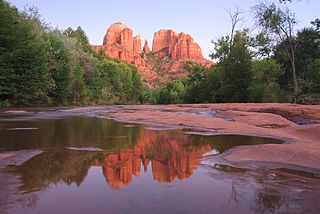Sedona, Arizona
| Sedona, Arizona | |
|---|---|
| City | |
| City of Sedona | |

Cathedral Rock in September 2009, from Red Rock Crossing
|
|
 Location in Yavapai County and the state of Arizona |
|
| Coordinates: 34°51′36″N 111°47′21″W / 34.86000°N 111.78917°WCoordinates: 34°51′36″N 111°47′21″W / 34.86000°N 111.78917°W | |
| Country | |
| State |
|
| Counties | Yavapai, Coconino |
| Founded | 1902 |
| Incorporated | 1988 |
| Government | |
| • Type | Council-Manager |
| • Mayor | Sandy Moriarty |
| Area | |
| • Total | 49.7 km2 (19.2 sq mi) |
| • Land | 49.6 km2 (19.2 sq mi) |
| • Water | 0.1 km2 (0.04 sq mi) |
| Elevation | 1,319 m (4,326 ft) |
| Population (2010) | |
| • Total | 10,031 |
| • Estimate (2014) | 10,281 |
| • Density | 202.4/km2 (524/sq mi) |
| Time zone | MST (UTC-7) |
| ZIP code | 86336 |
| Area code(s) | 928 |
| FIPS code | 04-65350 |
| Website | www |
Sedona /sᵻˈdoʊnə/ is a city that straddles the county line between Coconino and Yavapai counties in the northern Verde Valley region of the U.S. state of Arizona. As of the 2010 census, its population was 10,031.
Sedona's main attraction is its array of red sandstone formations. The formations appear to glow in brilliant orange and red when illuminated by the rising or setting sun. The red rocks form a popular backdrop for many activities, ranging from spiritual pursuits to the hundreds of hiking and mountain biking trails.
Sedona was named after Sedona Arabella Miller Schnebly (1877–1950), the wife of Theodore Carlton Schnebly, the city's first postmaster, who was celebrated for her hospitality and industriousness. Her mother, Amanda Miller, claimed to have made the name up because "it sounded pretty".
The first documented human presence in Sedona area dates to between 11,500 and 9000 B.C. It was not until 1995 that a Clovis projectile point discovered in Honanki revealed the presence of the Paleo-Indians, who were big-game hunters. Around 9000 B.C., the pre-historic Archaic people appeared in the Verde Valley. These were hunter-gatherers and their presence in the area was longer than in other areas of the Southwest, most likely because of the ecological diversity and large amount of resources. They left by 300 A.D. There is an assortment of rock art left by the Archaic people in places near Sedona such as Palatki and Honanki.
...
Wikipedia
